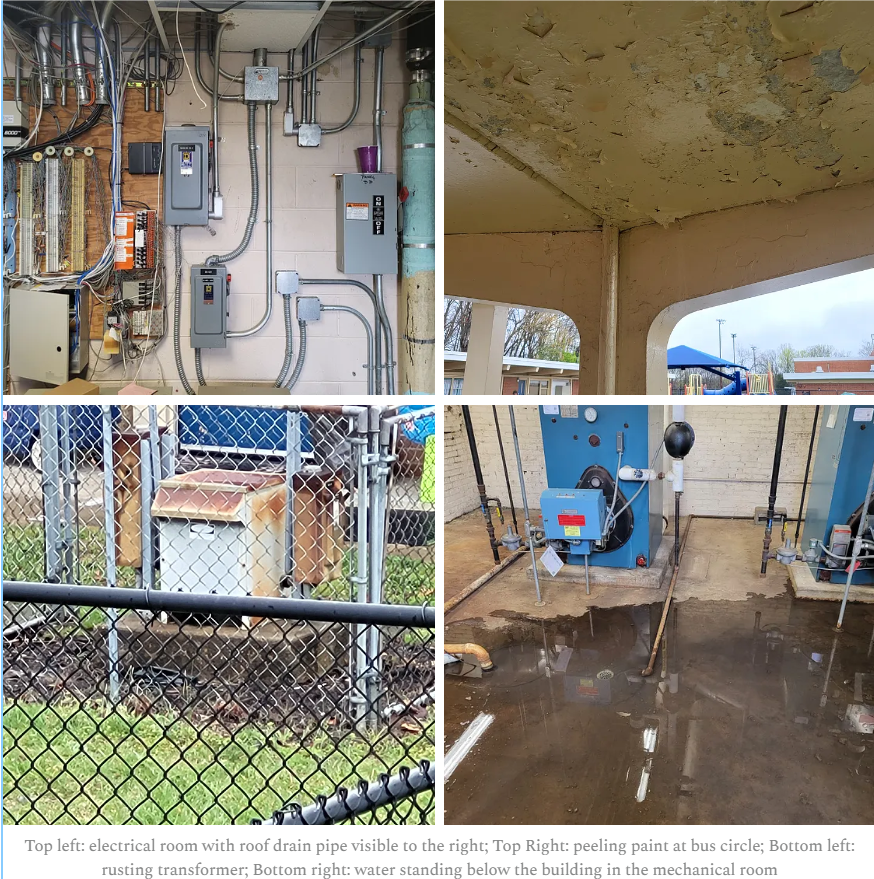In Spotsylvania and Stafford counties, school facilities are underfunded, and the impacts include safety, academic performance, and community involvement. Addressing the problem requires a new way of thinking.
by Martin Davis
EDITOR-IN-CHIEF
School facilities have become major issues in Fredericksburg city, as well as Spotsylvania and Stafford counties. This should be a surprise only to those whose lives are not touched by schools. And there are precious few of us. Consider:
- These three school systems serve about 58,000 students, more than half of that number are in Stafford County.
- Several local religious communities depend upon our public schools to serve their members. Every Sunday, for example, there are church services held at Riverbend High School, Courtland High School, Chancellor High School, North Stafford High School, Brooke Point High School, and Colonial Forge High School.
- Some travel sports programs are dependent upon public school gyms and fields to run their programs. Among the local teams that practice and play at these public school facilities are: Fredericksburg Soccer Club Incorporated (Phoenix), Spotsylvania Youth Football Association (Cougars), and Stafford Soccer.
- Every fall, people from across the community come together for Friday Night Lights.
Our public schools, in other words, are public assets. They are the centers in which the vast majority of our regions’ children are educated during the day, where citizens young and old come to worship, where our children live out their own personal “glory days,” and we come together as a community to cheer one another on.
The importance of the role these facilities play in our lives makes it hard to comprehend what has become obvious – These public assets are not being properly supported.
Putting Lipstick on a Pig
A series of stories in the Advance have exposed the extent to which we have underfunded our schools’ physical facilities in both Spotsylvania and Stafford counties, which has led to districts deferring maintenance for decades. For a time, the effects of this underfunding were somewhat easy to mask. Students are in classrooms, after all, not the boiler rooms, and visitors don’t spend time walking on roofs or looking at backed-up drains.
Because people don’t see the problems, however, doesn’t mean the damage isn’t there. As one public school employee in our region, who asked not to be named, recently told the Advance, “We’re putting lipstick on a pig.”
In Spotsylvania County, aging HVAC systems are burning through cash, eating up money that could be better spent in other places were more-energy-efficient systems installed. As the Advance has reported, however, that’s far from the only issue. In fact, even the county doesn’t currently understand the full extent of the work that needs to be done to get buildings into the peak condition. That’s why the school division is undertaking an assessment of the existing mechanical, electrical, plumbing, and roofing conditions so that it can prioritize the repairs that demand the greatest attention.
Beyond the physical damage is the fact that the problems with these facilities, coupled with the changing student demographics in Spotsylvania, mean that the county is effectively losing classroom space every year problems are allowed to continue uncorrected.
The issues are no better in Stafford. Recently, the realities of underfunding maintenance literally burst into view. At Rodney Thompson Middle School, the bladder in a hot water expansion tank failed causing pressure in the system to spike out of control and as a result, a pipe in the cafeteria burst and poured boiling, 165-degree water into the room and surrounding hallway.
This is not a one-off situation.
Last week, the Advance was taken on a tour of the Rising Star Early Childhood Education Center. Located just off of 17 near the interstate, the original building was constructed in the 1930s, and has been added to multiple times over the years.
The problems facing the teams that must maintain this facility are abundant. The schools’ thermostats and dampers use pneumatic controls, for example. This system, which depends upon air pressure, is not just out-of-date and inefficient, but it’s difficult to repair. “It’s hard to find people to work on these systems,” says Jason Towery, executive director of facilities and maintenance for the school system.
He also notes that what happened at Rodney Thompson Middle School happened at Rising Stars two years ago. Then, fortunately, it happened below the building.
During our tour, the Advance witnessed a number of concerning issues: fuse boxes using fuses for which parts are no longer available. The awnings that line the bus circle to keep children dry on days that it’s raining are peeling and require near-constant scrapping. The sewage pipe that supplies the building is failing, which leads to backup at times in some of the bathrooms. The main electrical room, which was built in the 1950s or 60s, features a roof drainpipe in a room packed with electrical equipment.

“For our maintenance crew,” said Towery, “we don’t have confidence in our equipment and facilities. This brings a lot of concerns along the lines of ‘what’s going to go wrong today?'”
There is abundant evidence to backup Towery’s concerns. Facility Condition Assessments recently completed reveal the extent of the work facing schools in the division.
Of the 34 schools and division facilities assessed by Bureau Veritas, 11 – or nearly a third – were rated as “Subjected to hard or long-term wear. Nearing the end of its useful or serviceable life” in three years. One facility – the one the Advance visited – is currently rated “Has reached the end of its useful or serviceable life. Renewal is now necessary.”
The cost to do the needed repairs is eyebrow raising. Towery estimates that the school needs about $20 million dollars a year just to keep up with the repairs and work that needs to be done. The county, however, hasn’t funded maintenance anywhere near that level in a decade or so. Consequently, Towery estimates that the school division is between $150 million and $200 million a year behind.
“We understand this is not an overnight turnaround,” Towery said. “This has to be a step-by-step process. We’re not asking the community to take the entire apple in one bite.”
The county took a bit of a bite recently when Stafford supervisors approved a budget for the upcoming fiscal year that will provide about $15 million to the school division for critical systems maintenance and repair, replacement, and renovation, or “3R” projects.
A needed and welcome start. But for a school system at least $150 million behind in maintenance, and growing at the rate of 700 elementary students a year, there’s a mountain to be moved if the county hopes to get control of a problem that has already gotten out of hand.
A Matter of Trust
This level of underfunding in Spotsylvania and Stafford go beyond politics and debates about taxation.
Asked why this level of underfunding has been allowed to continue for as long as it has, Towery put his finger on the issue.
“I think Stafford County and the citizens of Stafford value the kids and the teachers. But there has been some ‘lack of trust.’ Trying to rebuild that is difficult for the community at large, to put that trust back in the schools at this point, that we know what we’re doing, that we have a handle on our facilities, and that what we’re saying truthful, and that we need the community’s help.”
At this point, why that public trust has been lost is a matter best left to academics a generation from now, who will have the time, perspective, and appropriate distance to understand where we’ve gone wrong.
For now, it’s important that we rediscover trust in one another and our public institutions to ensure that we are doing what is best for the generations on the rise. And for the tens of thousands of people expected to move into our region over the next 25 years.
There are no easy paths to restoring trust, but one thing that can help is a change in the way we think about schools.
More than centers for education that run 7.5 hours a day for approximately 36 weeks, these are community centers that operate year-round and benefit far more people than the teachers, students, and administrators who work in them.
It won’t make the financial realities sting any less, or reduce the burden we will all have to bear to fix this situation.
But this change in perspective gives us something to strive toward, and not fight one another over.
Coming Soon: Re-envisioning school facility upkeep.



